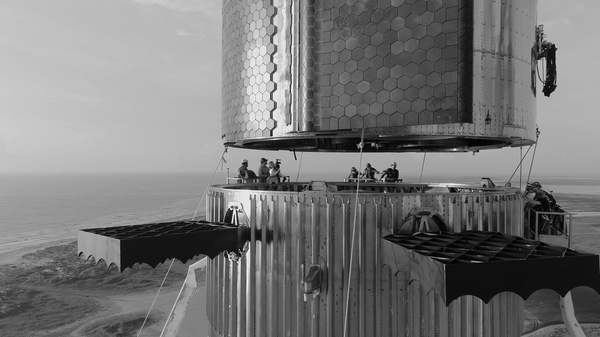Will SpaceX follow Tesla to a $1 trillion market capitalization?by Sam Dinkin
|
| I predicted in 2006 that Musk might get a high-nine-figure payout from SpaceX via a Netscape moment; SpaceX is now capitalized at approximately $100 billion—12 figures. |
Capital utilization for a Mars fleet will be much lower than for the Moon or in LEO unless the ships are put to work doing something between trips (about 8 months out of 26). The maximization of Elon Musk’s objective of settling Mars may force launch capacity well above the profit-maximizing level looking at customer demand alone. A larger fleet reduces the cost per flight and speeds the pace of Mars settlement.
While I predicted in 2006 that Musk might get a high-nine-figure payout from SpaceX via a Netscape moment (see “Backgrounder: SpaceX making history”, The Space Review, February 27, 2006), SpaceX is now capitalized at approximately $100,000,000,000—12 figures—and a recent Morgan Stanley poll found investors expect it to eventually be worth $1,000,000,000,000—13 figures—like Tesla, which broke through that market capitalization this week on the announcement of a purchase of 100,000 Tesla sedans by Hertz for car rental.
The Morgan Stanley poll results were attributed to the expected value of the stream of Starlink income for Internet service. This may understate the potential for other such use of plentiful and lower-cost wholesale space-launch capacity to provide other services directly. As Casey Handmer writes in a blog post titled “Starship is still not understood”: “Annual capacity to LEO climbs from its current average of 500 T for the whole of our civilization to perhaps 500 T per week. Eventually, it could exceed 1,000,000 T/year. At the same time, launch costs drop as low as $50/kg, roughly 100x lower than the present. For the same budget in launch, supply will have increased by roughly 100x. How can the space industry saturate this increased launch supply?”
Other services
Starlink is already considering expanding from fixed broadband to mobile broadband for maritime and aviation use. Ruggedized terminals may make it possible for a truck or RV to access the system. It may make cellphone tower backhaul easier. This may mean more sources of demand for Starlink that could generate higher revenue than expected and perhaps justify an even more dense satellite network.
At 916 cubic meters, the International Space Station could be replaced with a Starship. With a 22-meter extended payload faring, the payload volume of the first 14 meters of the payload bay with an eight-meter diameter is already 704 cubic meters. In its Mars passenger configuration, Starship could have life support and power for 100 people for 9 months.
The imaging market is expected to be $7 billion/year by 2030. Like Starlink, SpaceX can orbit imaging capacity using its own wholesale launch costs and directly provide imaging much as it provides Starlink bandwidth. Increasing the competition in that market should reduce the price, which, in turn, would grow the market further. This opportunity is not necessarily as lucrative as new services. SpaceX would not be in a position to be first to market like it is with low-latency satellite home broadband, but imaging services already have a proven market.
| While SpaceX can undercut other company’s launch prices by so much that its wholesale cost is well below what the retail market will bear, its excess capacity can be used in innovative ways to provide old and new space services directly. |
Point-to-point suborbital flights is another potential market (see “Could suborbital point-to-point really be worth $20 billion a year in 2030?”, The Space Review, March 25, 2019). While that may be a goal that is more realistic for 2041 than 2030, it could potentially generate $20 billion per year in revenue (in 2020 dollars). Tesla only had $31.5 billion revenue in 2020. While it is unlikely for this spinoff to be worth $600 billion, it is something the flying public may pay for once the safety level is adequate (see “How safe is safe enough for point-to-point suborbital?”, The Space Review, April 22, 2019).
Offering a higher precision GPS ought to be straightforward with 30,000 satellites in orbit.
SpaceX can leverage its launch capacity into providing a LEO infrastructure, with Starships being used as:
- orbital propellant depots like terrestrial gas stations
- habitable volume
- consumables storage for water, air and food
All of these services, along with positioning and a data network, can be created and delivered to the Moon, too, in the off season between Mars transfer opportunities. If there is demand, these services can also be provided to Europa, Titan, Venus and wherever else someone wants to place them.
As Casey Handmer notes, “As of May 2021, it looks like SpaceX has a reasonably solid lead in launch. This isn’t preordained to last forever, especially as copying a finalized Starship will be much easier for competitors, liberally salted with former SpaceX employees, than getting the design right in the first place.” Once there are a few competitors, retail prices are likely to drop to near wholesale prices, at which point such new services will be decentralized. It will not require a SpaceX internal business to monetize launch capacity at that point.
While SpaceX can undercut other company’s launch prices by so much that its wholesale cost is well below what the retail market will bear, its excess capacity can be used in innovative ways to provide old and new space services directly. I doubt I will be off by a factor of over 100 on market cap again, but the upside for SpaceX market cap reaching $1 trillion by 2030 may still be understated.
Note: we are using a new commenting system, which may require you to create a new account.
